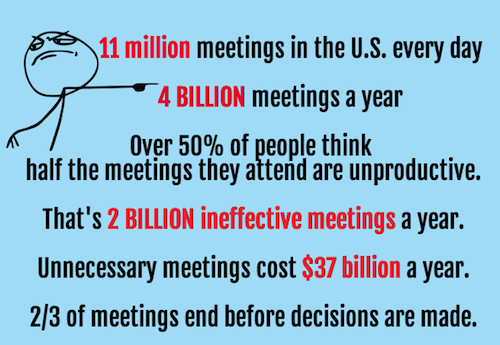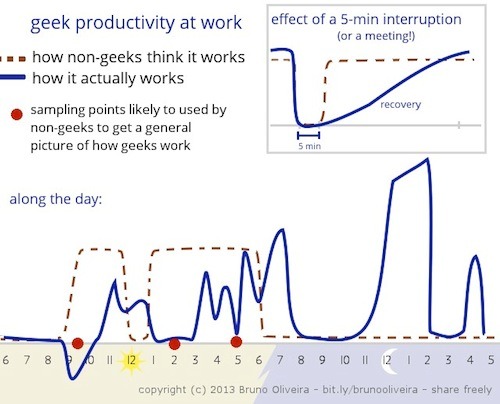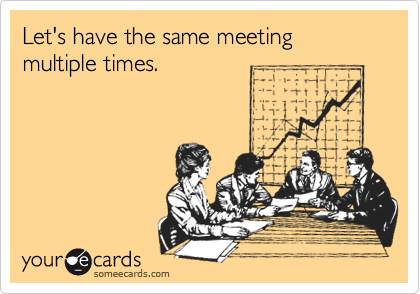Why do we continue to have bad meetings? Seriously, 99% of the human population seem to hate them, and there are surveys showing again and again that there are x many meetings every day that cost gabillions of dollars worth of wasted time and productivity.
Is it some horrible concoction of misplaced optimism that this time it’ll be better, resigned acceptance that this is a required dog and pony show — the business world’s tradition of dance, monkey, dance — and a massive buildup of bad meeting history that’s created such intense inertia that only superheroes can help us pull away into the light?
Imagine that a group of you had to build a doghouse like Snoopy’s, and you got a toolbox, some wood, and pencils and paper. Your team is revved up about this cool dog house, you can envision it, you have all these super useful tools, but all your team does with the pencils and paper is doodle pictures of cute dogs instead of making a blueprint or marking down measurements. Then when you run out of paper, you ask for more paper — only to doodle more pictures of dogs.
That’s how we’re treating meetings. Meetings are a helpful tool to decide and plan things. But misused, they’re just a bunch of meaningless doodles that don’t lead to anything being built and Snoopy with no place to live.

Recently Harvard Business School professor Nancy Koehn talked to NPR’s Marketplace about ineffective meetings. The estimates she cited include:
- 11 million meetings every day in the U.S.
- That means 4 billion a year.
- Over 50% of people surveyed said that half the meetings they attend are unproductive.
- That’s 2 billion ineffective meetings.
Want more depressing stats?
Kiss your $37 billion goodbye. That’s how much unnecessary meetings costs businesses every year according to the U.S. Bureau of Labor statistics. And most meetings, two-thirds of them to be precise, end before decisions are reached.
Koehn’s explanation for why we keep having fruitless meetings? Habit.
That’s the only way it makes sense that we keep repeating our unhealthy behavior: bad habits are irrational. They’re actions you can’t justify merely by saying, “well this is how I’ve been doing it” — just like how you can’t make any progress toward losing weight as a goal but keep eating and moving the same as you ever were.
But people overcome bad habits all the time by consistently trying to improve rather than repeat them. There are some common solutions to fixing meetings, such as sticking to stated starting and ending times, agendas, and plans; going into meetings with specific goals, and limiting participation to only those people who have to be in the room.
We thought we’d feature some lesser known tips on making the meetings you do have more effective (don’t forget that the poor things do have a purpose when they’re run well), which means fewer meetings and less wasted time.
Set a Meetings Cadence
When scheduled indiscriminately, meetings can be supremely disruptive and damaging to your productivity and flow.

Part of what makes meetings so overused is that they seem like an unlimited resource, so when you start setting and respecting some limitations on their frequency by designating no meeting days, people’s approach and behavior in meetings can click into focus.
Take Twitter and Square co-founder Jack Dorsey. His philosophy is that stress comes from the unexpected so that setting a cadence around your schedule keeps tensions at bay. So Dorsey sets aside Mondays for meetings. So too does Jon Steinberg, president, and COO of Buzzfeed, who was inspired by Dorsey to set a meeting cadence. He considers Mondays his “internal meeting day” in addition to deliberately scheduling Tuesdays and Thursdays as “no meeting” days.
The gourmet snack subscription service Love With Food also sets a meeting rhythm. By virtue of its alternating co-location and remote working schedule, the startup limits its meetings to when people are physically in the office every Monday, Wednesday, and Friday. Because there’s a set cadence, founder Aihui Ong notes that it forces people to be deliberate about scheduling and to maximize the effectiveness of the face-to-face time they have with each other.
Write Stuff Down and Get Rid of Presentations
Amazon’s Jeff Bezos starts his senior executive’s meetings off with half an hour of total silence. Everyone reads a six-page memo that has been prepared in advance. This is effective because it gets clear thoughts and argument down in writing, all structured to reach towards answering the question of “now what?” in the discussion that follows.
LinkedIn CEO Jeff Weiner also takes a page from Bezos’s meeting playbook by starting each meeting with five to ten minutes to read over materials sent out in advance, figuring quite rightly that “just because the material has been sent doesn’t mean it will be read.” The specific reason behind this quiet reading time is that LinkedIn has eliminated presentations in meetings — no more Powerpoints, no more droning on, no more snoozing while people try to get you up to speed.
Weiner discovered that getting rid of presentations focuses the meeting’s contents and shortens its duration, getting to “now what?” much more quickly.
With the presentation eliminated, the meeting can now be exclusively focused on generating a valuable discourse: Providing shared context, diving deeper on particularly cogent data and insights, and perhaps most importantly, having a meaningful debate.
Start With Wins
Weiner also starts status meetings with something surprising. Instead of diving straight into business, he asks everyone to go around and share their wins of the week, “one personal victory and one professional achievement.” While this might sound like it wastes more time, it actually ends up focusing people by putting them into a positive frame of mind to tackle issues and talk metrics without turning into an unproductive, repetitious “round robin of complaints.”
* * * * *
When we talked with ShopLocket CEO and co-founder Katherine Hague, she pointed out the importance of noting what kind of work is getting done every day. There’s maintenance or even busy work like doing email all day that can trick you into feeling like you’ve been quite productive. And then there’s the work that is “forward-moving for the company”, which means you’re getting stuff done that really matters.
Palantir’s Michael Lopp (Rands) notes then how meetings aren’t for discussing things that can be documented like status updates, spreadsheets, or bug reports but for discussing “what’s important, what you care about this week, this month and this year. What’s working and what isn’t and what’s going to be fixed.”
Changing our bad meeting habits means thinking about what about them is moving you forward, what do they address that you actually care about? Let’s stop accepting the bizarre notion that it’s proper, even responsible, to continue doing something that doesn’t actually move your organization or your people forward.
Liked this post? Subscribe to our free newsletter for great content on management, productivity, and company culture!


